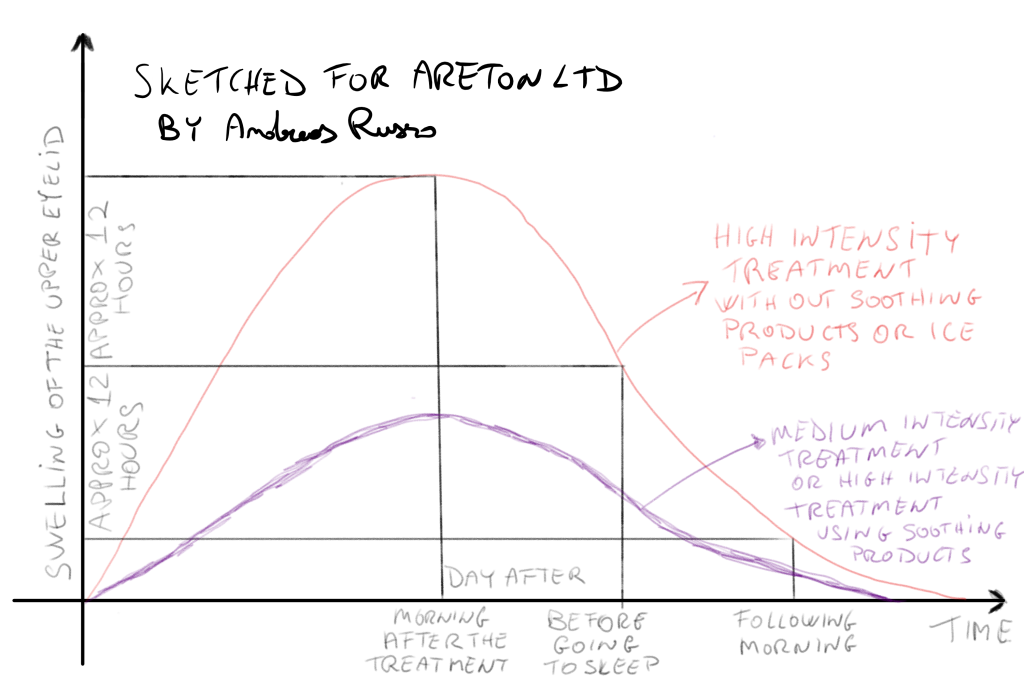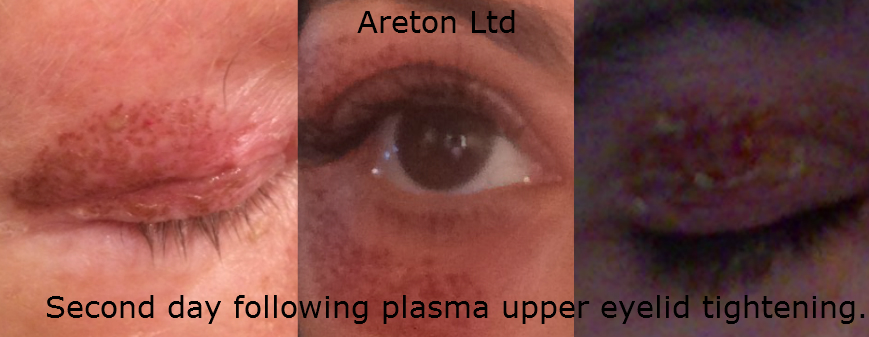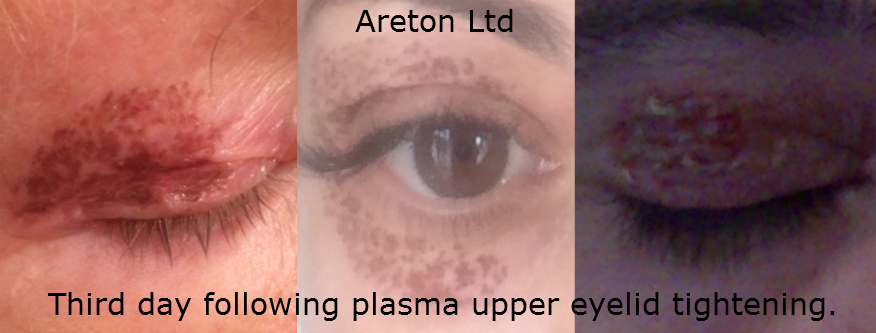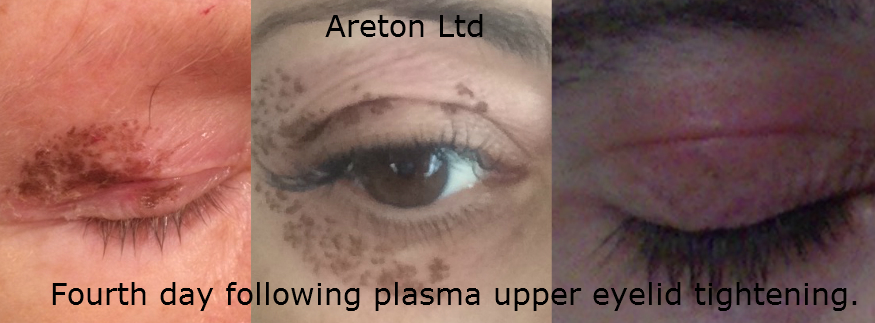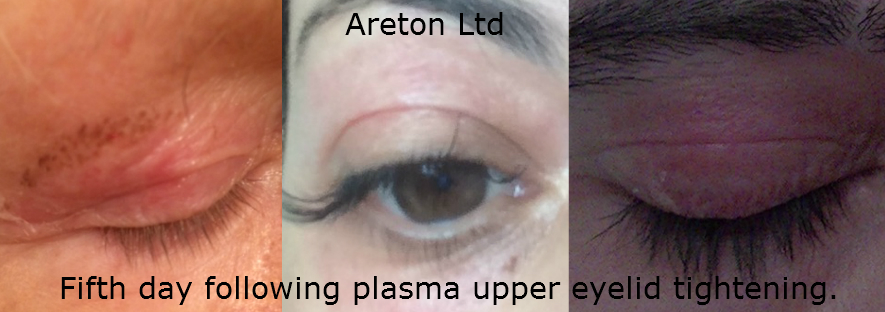[:en]
Plasma eyelid tightening is an effective treatment which produces results and like most effective aesthetic treatments, the area will “get worse before it gets better”.
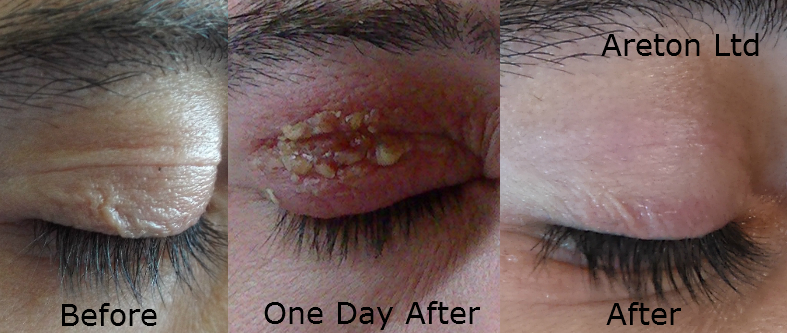
The leftmost picture depicts the upper eyelid before any plasma upper eyelid tightening treatment was carried out. The middle picture is a detail of the right eyelid the day after one of the plasma upper eyelid tightening treatments. The rightmost picture is an after picture several months after the last plasma eyelid tightening treatment. As seen here, despite the dramatic immediate after effects of the voltaic plasma eyelid tightening no signs of the procedure are left.
Plasma eyelid tightening is an effective treatment which produces results and like most effective aesthetic treatments, the area will "get worse before it gets better".
In this page we will focus on one of the most important issues in Plasma Upper Eyelid tightening, the healing process and its progression. Surprisingly, this is not a talked about subject anywhere, therefore we decided to focus on this issue because this has been the cause of concern for several clients who underwent this type of aesthetic procedure and were not correctly informed about these reactions to Plasma Upper Eyelid tightening.

In the middle of this picture there is yet is another example of dramatic swelling which occurs the day after plasma upper eyelid tightening. Inevitably the swelling subsides on its own accord without the use of any medicine or medical attention.
The swelling following upper eyelid tightening had been the major cause of concern for those clients who underwent the treatment and it has also been the source of speculation about Plasma Upper Eyelid Tightening treatments in general. As we will see this is a completely normal reaction to this type of aesthetic treatment which has to be expected in all cases.
We have grouped this information openly available, so that-any one who performs these types of treatments or undergoes plasma eyelid lift can have a point of reference. In this way not only who performs the treatments for the first time and also those who undergo them are made aware in detail of what to expect.
As we will see, the symptoms during the healing process can be dramatic, however they are all transient and they do not require medical attention. They will al subside on their own accord within a few days after the treatment.
Please note that we will only focus here on the short-term healing process, the long-term healing progression is not covered here.
The healing process after plasma upper eyelid tightening is rather similar to that of localised plasma skin tightening on other areas of the face and body. Some degree of minor swelling and discomfort are experienced after plasma localised skin tightening treatments in general, however these are not generally a cause of concern or alarm. The healing after localised plasma skin tightening on most parts of the body involves:
- Minor Swelling
- Minor Burning sensation,
- Slight Discomfort
- Scabbing.
After plasma upper eyelid tightening the symptoms are similar but magnified and dramatic. This is due to the intrinsic sensitivity of the upper eyelid, which is notoriously more delicate than the other parts of the skin. The upper eyelids are more delicate and sensitive than the order parts of the body.
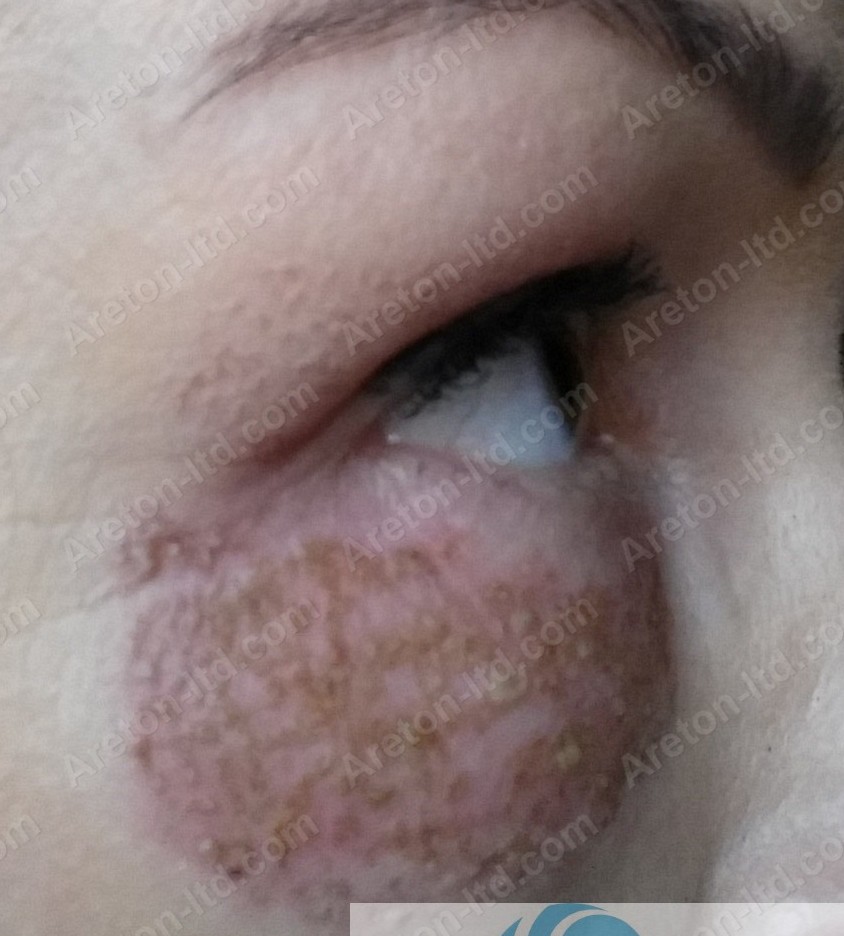
Minor swelling experienced the day following lower eyelid tightening. This is only minor compared to the swelling experienced after upper eyelid tightening.
After plasma upper eyelid tightening using voltaic plasma, swelling is much more dramatic that the one experienced after localised plasma skin tightening, the burning sensation is more accentuated discomfort and burning sensation are more intense and sometimes more difficult to cope with. etc. In particular not only the swelling is more dramatic but, while in localised plasma skin tightening, where is the swelling is only minor and confined to the treated area, in upper eyelid tightening the swelling can also spreads to the lower eyelids.
In other words everything that happens during the healing process after plasma localised skin tightening on most parts of the face and body also occurs after upper eyelid tightening but most symptoms are more dramatic.
In Plasma Upper Eyelid Tightening the area "gets worse before it gets better". Because of this, one of the main issue is the normal dramatic reactions which occur following the treatment, especially the swelling of the upper eyelids. However swelling is a natural reaction to the burn induced by the voltaic arc and it is not only to be expected but it is exactly what is needed in order to achieve the upper eyelid tightening sought by the clients.
Also, some of the aesthetic practitioners new to this type of procedures, can sometimes be caught by surprise by these reactions during the healing period.
The confusion about the healing process after plasma upper eyelid tightening is primarily due to the fact that there has not been sufficient structured information exploring in detail the healing process, this has caused unnecessary anxiety to some people undergoing treatment.
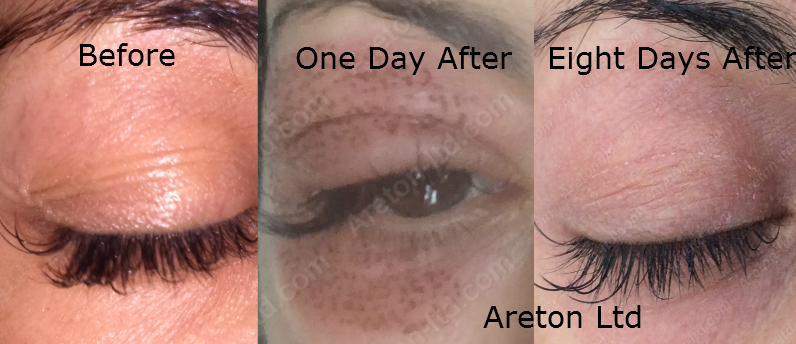
In the middle we can see how the severe swelling can make it difficult to open the eyes fully. This occurs only the morning following the plasma treatment. This is a normal reaction to be expected after this type of aesthetic treatment.
The normal healing process of Plasma Upper Eyelid tightening involves:
- Major swelling of the upper eyelid the day following the treatment (lasting 24 to 48 hours). The swelling of the lower eyelids (eye-bags) can occur even if the lower eyelids have not undergone any treatment (lasting up to 72 hours).
- Intense burning sensation (lasting 12 to 24 hours).
- Discomfort (lasting 24 to 48 hours).
- Pain (lasting 12 to 24 hours).
The sometimes dramatic upper eyelid swelling and discomfort experienced after plasma eyelid lift had been cause of worry (and even distress at times) to those people undergoing plasma upper eyelid lift but were not well informed about the immediate effects of procedure. Although they may appear dramatic, pain, discomfort and swelling after plasma upper eyelid tightening should not be cause for concern.
As we will see these symptoms are all normal effects which are transient and to be expected in all cases. None of the above effects can be completely avoided because they are caused by the very nature of the plasma aesthetic treatment itself (i.e. an intentional controlled skin burn). However they can be somewhat attenuated by using certain products and lowering the overall intensity of the treatment.
The information reported about the pain experienced is based on the feedback received by the people who underwent these types of aesthetic treatments over the years (several hundreds).
As we know the pain is caused by the burn inflicted during the treatment, therefore this is a normal reaction to this type of aesthetic procedure. Pain lasts up to 24 hours in most cases. The second day following the treatment is mostly pain-free and the pain is replaced by a feeling of slight discomfort first and itchy sensation after.
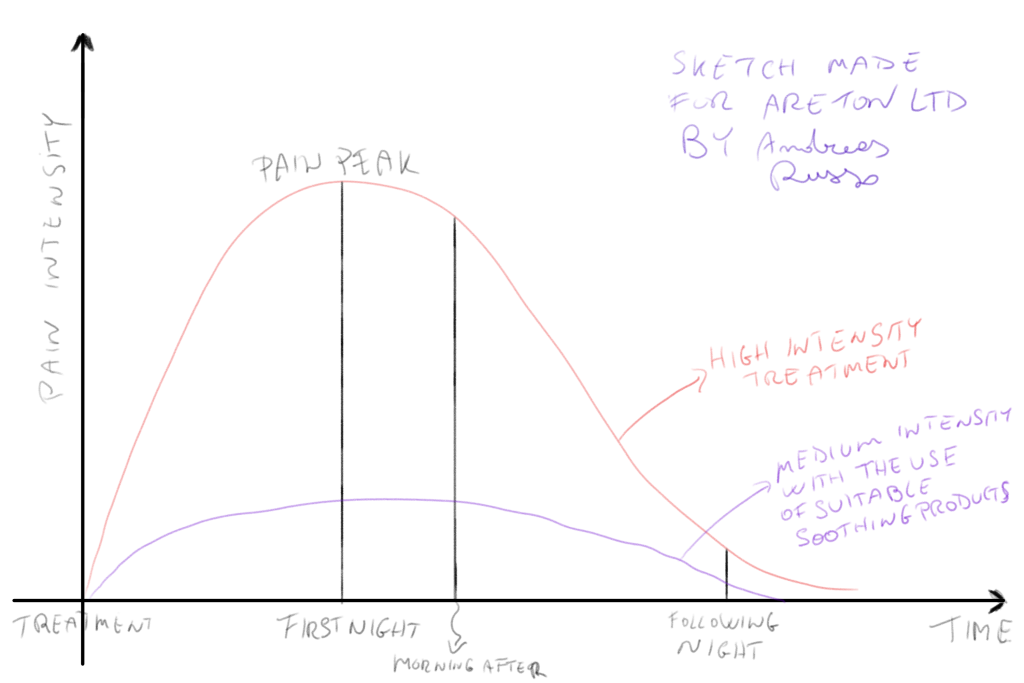
The pain after plasma upper eyelid lift is very subjective,however this representative sketch provides an idea of the way pain is experienced.
While discomfort is experienced by everyone undergoing plasma upper eyelid lift in different ways, on the other hand the pain experienced after the treatment is dependent on the particular individual sensitivity to pain. Sometimes pain is not reported at all. In fact there had been several cases where the individuals never reported pain as such, just discomfort.
The level of pain experienced (by people who are particularly sensitive to pain) also goes hand in hand with the level of swelling. Generally, the more the swelling the more the pain experienced.
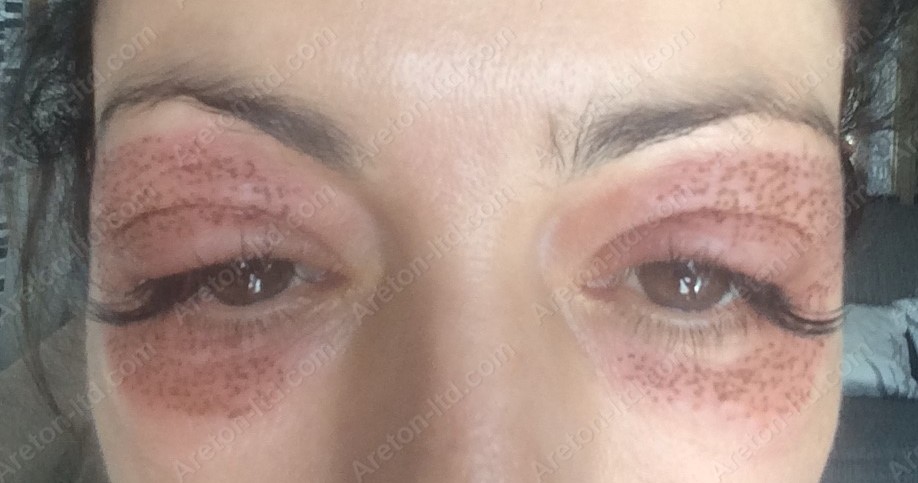
The upper eyelid swelling can make it difficult to fully open the eyes the morning following the treatment. The pain experienced and swelling go hand in hand. When the swelling is at its peak this is also when the pain experienced is at its highest. As the swelling subsides the pain and discomfort subside too. The pain and discomfort are replaced by an itchy sensation when the scabs start to develop.
In general the level of pain experienced is dependent on:
- the sensitivity of the particular individual to pain,
- the intensity of the voltaic plasma treatment. The lower the intensity of the treatment the less pain experienced during the day following the treatment. The higher the overall intensity of the treatment the more the pain felt after,
- the use of soothing products immediately after the treatment and during the healing process, including the use of ice packing.
Please note that the use of drugs for pain relief is possible, however seldom necessary and not as effective as the use of the appropriate topical soothing products.
Three cases will be presented here and as we will notice the patten in the skin recovery is similar, the upper eyelids swell in very similar ways. The degree of predictability of the swelling is relatively high. Also the swelling subsides in similar ways making its development a very predictable phenomenon. Furthermore, it can also be reliably predicted when the swelling is supposed to subside completely.
In the cases presented:
- No ice packing or any soothing products were used.
- The treatment intensity applied was also particularly high.
- The healing occurred without the help of any medication or drugs.
Although three representative cases are presented here with photographic evidence, over 300 cases were also examined and they reported the same or very similar healing patterns. Given the high number of the cases examined these are deemed sufficient to bring forward reliable conclusions about the issue of swelling after plasma upper eyelid tightening. There could be some minor statistical deviations, however these are not considered to be very significant given the large number of cases observed and feedback reported to date.
This is the swelling which occurs the day following the treatment. As seen in the pictures below the degree of swelling is very similar in all three cases.
The second day after the treatment, the swelling have subsided either completely or almost completely. Because the swelling subsided, everyone is able to open their eyes without major issues. All the three subjects presented were able to open their eyes fully on the second day right from the morning. Sometimes the swelling on the second day spreads in the lower eyelid. By the second day the pain is gone in all cases and replaced by a slight discomfort.
On the third day all swelling subsided completely. The residual swelling of the lower eyelid has either subsided or almost subsided. In all cases the eyes can be fully opened. No more discomfort is reported and it is replaced by an itchy sensation instead. The scabs have fully formed.
The scabs have fully formed and they start to fall off on their own accord. No more discomfort is felt and the itchy sensation has intensified.
The area looks slightly irritated but returned to almost normal and the long-term recovery takes place. At this point most people will we unable to tell the area undergone any aesthetic treatment.
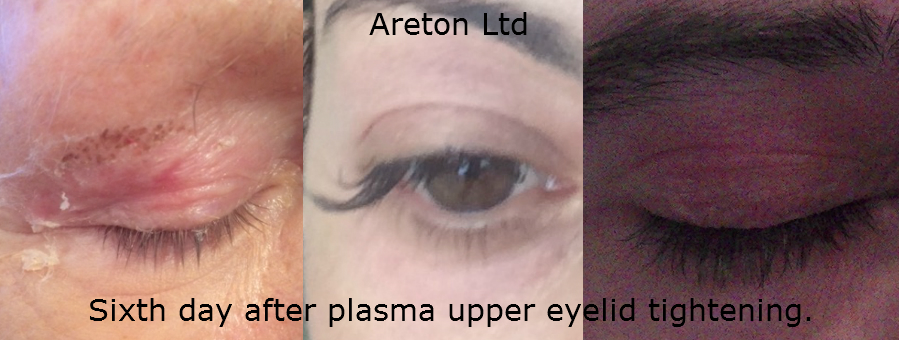
The sixth day all scabs are normally fallen off. No signs of the treatment are normally noticeable. Only on some rare cases some residual scabs are still to fall off as shown on the leftmost picture.
At the time of the treatment, the individual on the left was 66, 44 in the middle and 34 years of age on the right respectively. The pictures show how the healing appears to occur faster on the youngest subject and slower on the older ones. No sufficient cases have been examined in order to bring forward a conclusive opinion on the matter of speed of healing relative to the age of the individual.
Eyebag swelling is another reaction to be expected after the plasma upper eyelid lift. This has also been a cause of concern for clients who had undergone these types of treatments but were not aware of this type of short-term reaction.
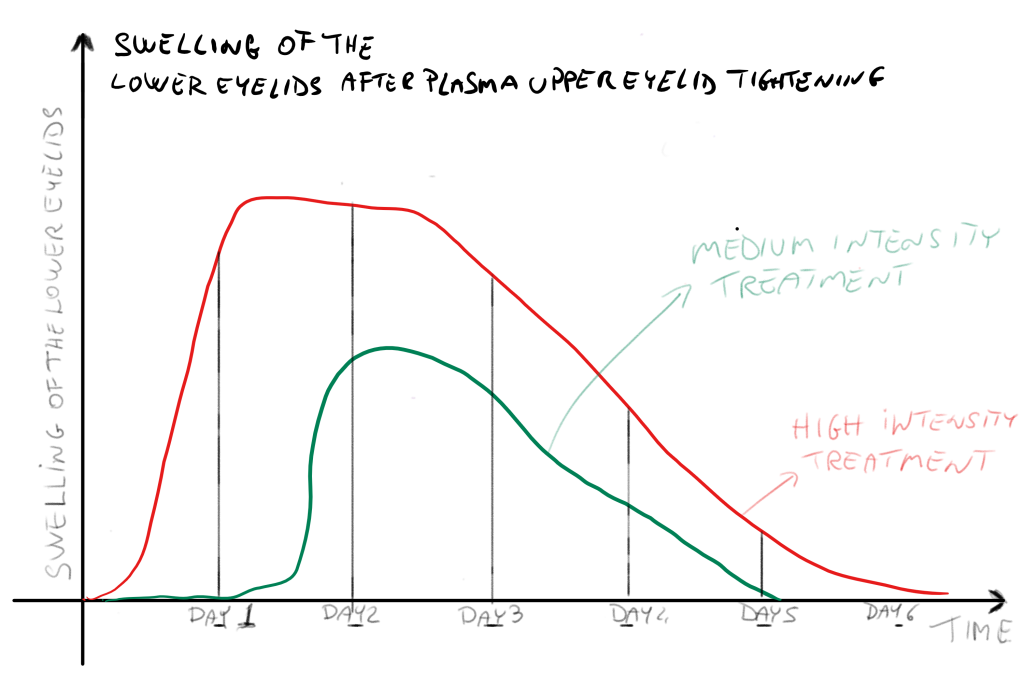
At a certain point during the healing process, although the lower eyelids had not undergone any treatment at all, they often swell too. It is interesting that the lower eyelids (or eyebags) swell even if no treatment has been performed to the area. This is because the upper and lower eyelids are interconnected, therefore the fluid produced, after the controlled burn on the upper eyelids tends to travel to the eyebags. The way the lower eyelid swelling can occur varies from person to person and sometimes it may even not occur at all, especially in case of low/medium intensity treatment coupled with the use of the appropriate soothing products. However, this reaction has to be expected in any case.
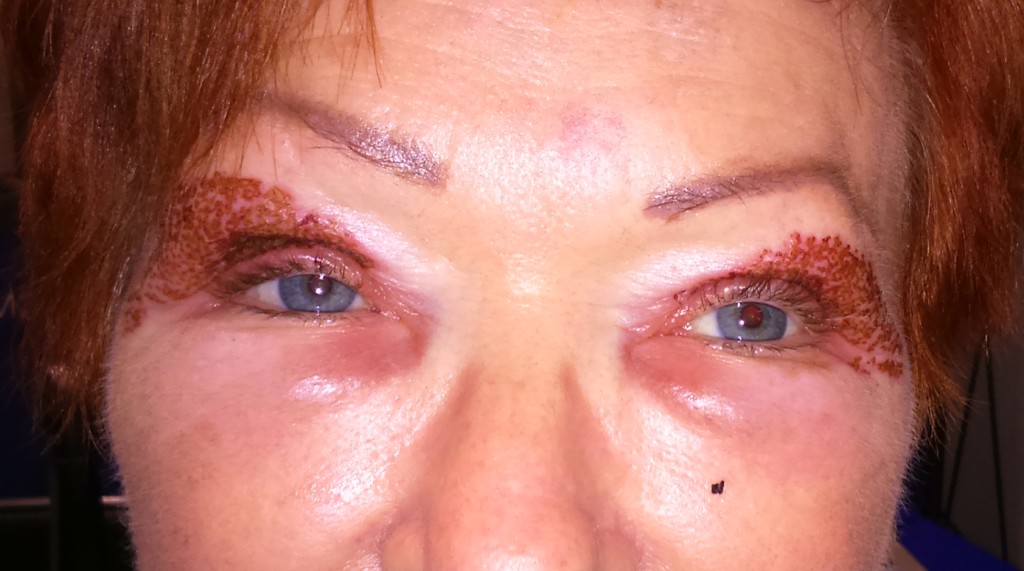
Second day following plasma upper eyelid tightening high intensity treatment. The upper eyelid swelling has almost completely subsided but the swelling appeared on the lower eyelids (eyebags instead). The fluid transferred to the eyebags.
The swelling of the lower eyelid can occur either the day after the treatment coupled with the swelling of the upper eyelid but it often occurs the second day after the treatment. The lower eyelid swelling is caused by the fluid on the upper eyelids transferred to the eyebags during the second night after the treatment. As we know in any case the fluid will be naturally absorbed by the body and will leave no trace. In conclusion, the swelling of the lower eyelids is transient and will subside completely on its own accord without the use of any treatment of any type or medication.
The following table goes through the healing progression after plasma upper eyelid lift in detail. The table has been built based on our experience and feedback received after treating hundreds of people using plasma devices for aesthetic purposes. Please note that any individual reaction could differ to a certain extent from what described therein based on:
- technique used,
- overall treatment intensity,
- individual reaction to the treatment.
However as a rule of thumb, if the swelling has not subsided completely by the fourth day after the treatment and the scabs have not formed yet, contact your aesthetic practitioner.
[table caption="All information an know-how of these procedures are detailed on the online training platform VoltaicPlasma.com " width="800" colwidth="500|500|300|200|200" colalign="normal|normal|normal|normal|normal"] How it Looks, How it Feels,Recommended Treatment, Optional treatment,Time Lapse Only slight swelling. However increasing towards the night, An intense burning sensation will hit as soon as the effect of the topical numbing product has subsided. Pain or discomfort will increase towards the night, Avoid dusty environments and all contact with dirty linen. Rinse with cold water. Wash using delicate neutral soap only if the area had been in contact with dust or unclean clothing. , Apply ice packs and/or the appropriate soothing product recommended by your aesthetic practitioner., One hour after the treatment up to the first night. The swelling has increased, Pain and Discomfort have intensified, Before going to sleep wash the area neutral soap; Use only cold water; Dry by patting very gently with a clean towel. Make sure you do not apply any product not recommended by your Aesthetic Therapist. Make sure you only use fresh and clean bedding., Apply ice packing and/or reapply the soothing product before going to sleep.,Before going to sleep. The first night after the treatment. Swelling intensifies during the night,Very high intensity treatments may cause difficulty sleeping only the first night before the treatment. This may not be the case for medium/low intensity treatments associated with the use of suitable soothing products, Make sure you only use fresh and clean bedding, Not applicable,First Night After the Plasma Eyelid Lift Treatment. Swelling is now at its peak. Swelling cannot get worse it will only get better. Sometimes in case of high intensity treatments without the use of soothing products or ice packing it may be hard to open your eyes first thing in the morning.,Pain and Discomfort is still almost at its highest but slightly less than the previous night, Rinse with clean running water and wash with mild neutral soap, Apply the soothing product recommended by your aesthetic therapist and ice packing, First morning after the treatment. Swelling slowly decreases throughout the day. By night-time you will be able to open your eyes (in case you had trouble opening them in the morning). ,Pain and discomfort decreases slowly throughout the day. In case of high intensity treatments you should be able to carry out all your normal activities (provided that they do not increase the chances of contracting any infection) however you do not at your best due to the swelling., Wash with mild neutral soap only if the area had been in dusty environment or in contact with dirty clothing, Apply the soothing product recommended by your beauty practitioner, Throughout the Day following the Plasma Eyelid tightening treatment; Afternoon/Night. Swelling will subside further throughout the night,You will be able to have a good night sleep and the pain or discomfort will be usually gone by the morning, Rinse and wash with mild soap before going to sleep, apply the soothing product before going to sleep for the last time; no more need for ice packing , During the second night following the treatment. Swelling should have almost completely subsided. You may find that your eyebags have swollen instead. The scabs should start to form where the treatment was carried out; there maybe minor traces of swelling on the upper eyelids; you will be able to open your eyes as normal. ,The discomfort should have gone completely and being replaced by an itchy sensation instead,Keep the area clean and avoid the use of any make-up, Not Applicable, Second day following the treatment. Swelling has subsided completely on the upper eyelids. You will be able to open your eyes fully as normal. Some minor swelling may still present on the lower eyelids (Eyebags). The scabs should have fully formed and they should start falling off on their own accord,No more discomfort should be felt; this is replaced by an itchy sensation ,avoid sun exposure and do not wear any make up,Not Applicable, Third day following the treatment. Scabs have started falling on their own. If previously swollen the eyebags should he returned to normal, Itching sensation at its peak., Do not pick the scabs and avoid the use of all make-up,Not applicable, Fourth Day following the treatment. Scabs should have fallen all off on their own accord. It is hard for most people to tell people you have undergone any treatment. However the area is still red and subject to further change over the coming weeks.,Itching sensation should start to subside. You usually find the area tender for a few weeks after the treatment. This is normal. You should not repeat the treatment before all tenderness is has subsided. When you apply creams you may feel the area still stinging. This is also normal. ,You can start using make up and you must use total sun screen before being exposed in the sun. Avoid exposing yourself to the sun as much as possible., You can apply Petroleum Jelly (e.g. Vaseline) if you feel the are being too dry, Fifth day onwards. [/table]Pain, discomfort, swelling of both upper and lower eyelids are all normal reactions to plasma upper eyelid tightening. Generally, they are all to be expected, however they all subside on their own accord without the help of any medical treatment or medication of any type.
In all cases examined, swelling pain and discomfort peaked throughout the night after the treatment and the following morning. The day following the treatment is also the most challenging as this is when the pain, discomfort and swelling peak.
Swelling of the lower eyelid was observed in some occasions the day following the treatment, especially when the treatment was carried out at high intensity and/or no soothing product or ice packing were applied to the area to soothe it. When the swelling of the eye-bags occurred, it was most often observed the two days after the treatment. Mostly, the swelling of the lower eyelid started to subside the third day after the treatment. In all cases the lower eyelid swelling subsided by the fourth day.
In most cases the scabs were fully formed on the third day after the treatment. However it has to be noted that scabs do not always form during the healing process.
In most cases the area returns to normal within 5 days (when all scabs have also fallen off by then). This usually marks the end of what most people perceive as "downtime". In all cases examined pain, discomfort swelling subsided without the help of any particular remedy or medication and the area eventually returned to normal.
No medical treatment was carried out in all cases (i.e. no medical consultation or use of any drugs or ointments of any type) and the area healed on its own.
Please bear in mind that most of the undesired reactions are due to poor after-care during the healing period.
Pictures and videos of the respective procedures.
Here we present the pictures used for this study. You can also watch the procedures where the video was available too.
Leftmost Subject Healing Process.
Here you will see the full healing progress over the period of 10 days. The subject was 66 years of age in 2015 at the time of the upper eyelid tightening procedure shown in the video. Only one eyelid was treated to show the difference between the eyelid treated and the one not treated. You will notice the difference in the after picture between the left and the right eyelid.
Centre Subject Healing Process.
The video below shows the plasma upper and lower eyelid tightening procedure. The pictures will show you the healing progression of over a period of 8 days after Eyelid tightening. The individual was 44 years of age at the time of the procedure.
Right most subject Healing Process.
These pictures show the healing progression after a medium intensity plasma eyelid tightening treatment using the spray mode. The individual was 35 years of age at the time of the specific treatment.
We will explore some of the myths about the healing (following upper plasma upper eyelid tightening) which is likely caused by the general lack of structured and organised information about what normally happens during the healing process. This has led in turn to the myriad of speculation around this simple aesthetic procedure.
Myth number one. Swelling is an adverse reaction to the treatment. It can sometimes occur after plasma eyelid tightening treatments but does not necessarily occur. If swelling occurs something is going wrong.
No. Swelling is a very normal and expected reaction to Voltaic Plasma upper eyelid tightening treatments. It always occurs after plasma eyelid lift treatments and can be minimised to a certain extent but never completely avoided, despite the device used for plasma eyelid tightening. All plasma upper eyelid tightening treatments will inevitably lead to some degree of swelling of the upper eyelid. Swelling is normal and there is nothing to be worried about when it is experienced. Swelling will subside on its own without the need of any treatment at all.
Myth number two. I need to be taking holidays and I have to be out of work for several days after the procedure because of the swelling caused by the Plasma Treatment.
Not true. Most people can return to their normal business activities immediately after this type of aesthetic procedure. It maybe harder to carry out your normal activities only the morning following the treatment, because this is when the swelling peaks. This peak in swelling can sometimes cause trouble opening your eyes fully or open them at all, but this only happens the morning after the treatment. Over the course of the day the swelling will inevitably start to subside and you will be able to open your eyes again by the evening. The second day the swelling of the upper eyelid will almost be gone in most cases.
Due to the possibility of severe swelling the morning following the treatment, it maybe advisable to only take one day off or carry out the treatment before the weekend, so that you can rest when the swelling and the pain are at their peak. Please note that not all swelling maybe major and most people are able to carry out their normal activities even the day following the treatment.
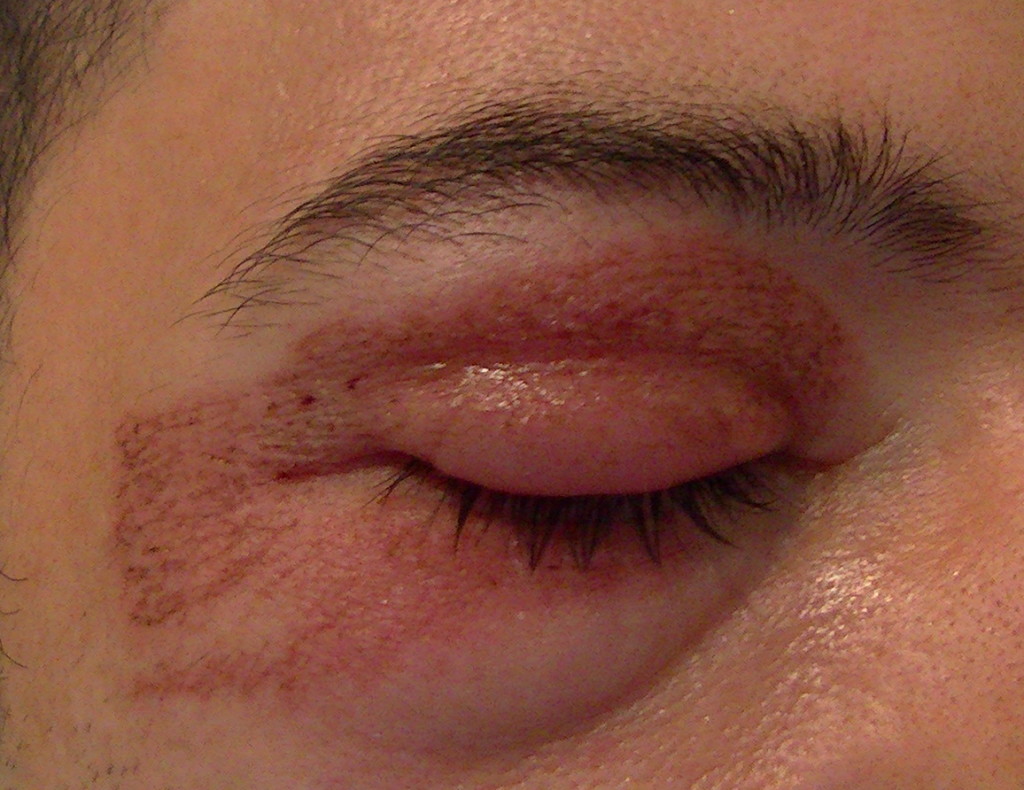
Example showing major swelling the morning after plasma upper eyelid tightening. The individual has undergone a very high intensity treatment without using any ice packing or soothing products. The swelling has spread to the lower eyelids too. Sometimes it may be challenging to open your eyes during the severe swelling, like in this particular case. The individual in this picture, took the morning and early afternoon off. He was travelling on business by the evening. Subject Andreas Russo, Areton Ltd's Managing Director as 2016.
However if the treatment has been carried out at low/medium intensity and the appropriate soothing product is used, then the peak of swelling experienced the morning following the treatment may be bearable and you may carry out any normal activities anyway.
During the healing period your eyes will be swollen to start with and the scabs will develop as the swelling subsides, therefore you will not look at your best, however if you are confident enough you can still carry out most of your normal activities other than being in the sun and expose yourself to dusty environments.
Myth number three. I will not be able to carry out my normal activities due to the "downtime" caused by the swelling.
The "downtime" is very subjective. This depends on the definition the individual assigns to the word "downtime". In most cases people refer to "downtime" (after an aesthetic procedure) as the period of time when it is possible to notice that some form of treatment was carried out. If this is the definition of downtime, then this will last as long as the scabs have not fallen off completely. Once the scabs have fallen off, normally it will be hard to tell any treatment was carried out.
In any case, despite the swelling you can carry out most normal activities right from the day after the treatment. The swelling peaks the morning following the treatment, therefore this is when you may find it harder to perform your usual tasks. Only at times the swelling can be so severe that you will not be able to open your eyes, but this does not happen all the time and the swelling subsides throughout the day. The second day following the treatment the swelling will have subsided dramatically and therefore in any case you should be able to perform most normal activities from the second day onwards.
Myth number four. Swelling after plasma upper eyelid tightening needs to be treated by a doctor.
NO. Swelling does not need to be treated by a doctor and it does no need any specialist treatment at all. The swelling caused by voltaic plasma eyelid lift treatments does not require any medical attention or pharmaceutical treatment because it is an expected reaction to the burn caused by the aesthetic treatment itself and it will subside inevitably on its own accord.
On the contrary, sometimes, the use of inappropriate products and treatments can lead to undesired adverse reactions. Therefore, if in doubt consult your aesthetic practitioner who has seen several of these reactions, leave the area alone and follow the directions provided by your aesthetic practitioner.
What requires medical attention are potential infections, however none have been reported to date.
Do not use any products which are not specifically recommended by your aesthetic practitioner. Medicines are not required and should not be used because they have their contraindications or may lead to adverse reactions.
Myth number five. Because of the swelling only doctors can perform this type of treatment.
Not true. Swelling will subside completely anyway despite the academic qualification of the person who carries out the treatment. Moreover the swelling will subside on its own accord, medical attention is not needed unless the swelling has not subsided the fourth day after the treatment.
Myth number six. Only doctors can safely perform Plasma aesthetic procedures Safely.
This myth was born from the need to sell devices to Doctors. Notoriously most self-employed Medical Doctors refuse to purchase any instrument or device which is also marketed to other aesthetic practitioners in general. Some companies have decided making the same or similar devices in different packaging in order to satisfy both markets (i.e. Doctors and aesthetic practitioners). One manufacturer in particular marketed to doctors only therefore has advertised their electrical plasma device as something that only doctors can use.
In practice to this date, these treatments have been performed safely by several aesthetic practitioners who are not medical doctors. We have examined the legislation and also made enquiries with the authorities on the matter. Up until January 2017 that there is no legislation in Europe which states who can use electrical plasma devices for aesthetic purposes. It is confirmed that as January 2017 no limitation to "doctors only".
Swelling and pain after plasma eyelid tightening are a normal and almost inevitable occurrence. This is because the plasma aesthetic skin tightening treatment causes an intentional superficial skin burn. It is somehow possible to reduce the swelling and the pain from the treatment using medium/mild intensity treatments associated with the use of suitable soothing products and/or ice packing, however due to the very nature of the treatment (an intentional superficial burn) swelling can be minimized or attenuated but never completely avoided.
Throughout our experience and the experience of many other aesthetic practitioners who carry out plasma upper eyelid tightening treatments, far too often phone calls are received from customers concerned by the swelling, pain and discomfort the day following plasma upper eyelid tightening procedures. The confusion and lack of information about the normal reactions during the healing process after plasma eyelid lift have also caused people to take unnecessary medication and use inappropriate products in order to "cure" these normal reactions.
As we now know, the healing progress follows always a specific and predictable pattern which "per se" does not require medical attention or "cure". Swelling discomfort or pain are all too normal and can be minimised but never completely avoided due to the nature of the aesthetic treatment itself.
For this reason this case study focuses on examining in detail pain, discomfort, swelling and the "downtime" throughout the first few days following plasma eyelid tightening. The time period which is of most concern to those who undergo plasma eyelid tightening.
Take Upper Eyelid Tightening Test Now Click Here
[:es]
El estiramiento del párpado con plasma es un tratamiento eficaz que produce resultados y, como la mayoría de los tratamientos estéticos efectivos, el área “empeorará antes de mejorar”.

La imagen de la izquierda muestra el párpado superior antes de realizar cualquier tratamiento de estiramiento del párpado con plasma. La imagen central es un detalle del párpado derecho el día después de uno de los tratamientos de estiramiento del párpado superior con plasma. La imagen de la derecha es una imagen posterior varios meses después del último tratamiento de estiramiento del párpado con plasma. Como se ve aquí, a pesar de los dramáticos efectos inmediatos del estiramiento del párpado con plasma voltaico, no quedan signos del procedimiento.
En esta página, nos centraremos en uno de los problemas más importantes en el ajuste del párpado superior con plasma, el proceso de curación y su progresión. Sorprendentemente, este no es un tema en el que se haya hablado en ninguna parte, por lo que decidimos centrarnos en este tema porque ha sido motivo de preocupación para varios clientes que se sometieron a este tipo de procedimiento estético y no fueron informados correctamente sobre estas reacciones al estiramiento del párpado superior con plasma.

En medio de esta imagen hay otro ejemplo de hinchazón dramática que ocurre el día después del estiramiento del párpado superior del plasma. Inevitablemente, la inflamación disminuye por sí sola sin el uso de ningún medicamento o atención médica.
La hinchazón posterior al estiramiento del párpado superior había sido la principal causa de preocupación para aquellos clientes que se sometieron al tratamiento y también ha sido la fuente de especulación sobre los tratamientos de estiramiento del párpado plasmático en general. Como veremos, esta es una reacción completamente normal a este tipo de tratamiento estético que debe esperarse en todos los casos.

En medio de esta imagen hay otro ejemplo de hinchazón dramática que ocurre el día después del estiramiento del párpado superior del plasma. Inevitablemente, la inflamación disminuye por sí sola sin el uso de ningún medicamento o atención médica.
Hemos agrupado esta información disponible abiertamente, de modo que cualquiera que realice estos tipos de tratamientos o se someta a un levantamiento de párpados con plasma pueda tener un punto de referencia. De esta manera, no solo los que realizan los tratamientos por primera vez, sino también los que se someten a ellos, se informan detalladamente de qué esperar.
Como veremos, los síntomas durante el proceso de curación pueden ser dramáticos, sin embargo, todos son transitorios y no requieren atención médica. Se retirarán por sí solos unos días después del tratamiento.
Tenga en cuenta que solo nos centraremos aquí en el proceso de curación a corto plazo a progresión de la curación a largo plazo no se cubre aquí.
El proceso de curación después del estiramiento del párpado superior del plasma es bastante similar al del estiramiento de la piel del plasma localizado en otras áreas de la cara y el cuerpo. Se experimenta cierto grado de hinchazón y malestar leves después de los tratamientos de estiramiento cutáneo localizados con plasma en general, sin embargo, estos no son generalmente una causa de preocupación o alarma. La curación después del estiramiento de la piel con plasma localizado en la mayoría de las partes del cuerpo implica:
- Hinchazón menor
- Sensación de quemadura menor,
- Ligera molestia
- Costras.
Después del estiramiento del párpado superior del plasma, los síntomas son similares pero aumentados y dramáticos. Esto se debe a la sensibilidad intrínseca del párpado superior, que es notoriamente más delicada que las otras partes de la piel. Los párpados superiores son más delicados y sensibles que las partes del cuerpo ordenadas.

Inflamación menor experimentada el día siguiente al estiramiento del párpado inferior. Esto es solo menor en comparación con la hinchazón que se experimenta después del estiramiento del párpado superior.
Después del estiramiento del plasma del párpado superior con plasma voltaico, la hinchazón es mucho más dramática que la que se experimenta después del estiramiento localizado de la piel con plasma, la sensación de ardor es más acentuada, la incomodidad y la sensación de ardor son más intensas y, a veces, más difíciles de manejar. etc. En particular, no solo la hinchazón es más dramática sino que, mientras que en la piel de plasma localizada el estiramiento, donde la hinchazón es menor y se limita al área tratada, en el párpado superior, la hinchazón también puede extenderse a los párpados inferiores.
En otras palabras, todo lo que sucede durante el proceso de curación después del estiramiento de piel localizada con plasma en la mayor parte de la cara y el cuerpo también ocurre después del estiramiento del párpado superior, pero la mayoría de los síntomas son más dramáticos.
En el estiramiento del párpado superior con plasma, el área "empeora antes de mejorar". Debido a esto, uno de los principales problemas son las reacciones dramáticas normales que ocurren después del tratamiento, especialmente la hinchazón de los párpados superiores. Sin embargo, la hinchazón es una reacción natural a la quemadura inducida por el arco voltaico y no solo es de esperar, sino que es exactamente lo que se necesita para lograr el estiramiento del párpado superior buscado por los clientes.
Además, algunas de las prácticas estéticas nuevas en este tipo de procedimientos, a veces pueden ser sorprendidas por estas reacciones durante el período de curación.
La confusión sobre el proceso de curación después del estiramiento del párpado superior del plasma se debe principalmente al hecho de que no ha habido suficiente información estructurada para explorar en detalle el proceso de curación, esto ha causado una ansiedad innecesaria a algunas personas que reciben tratamiento.

En el medio podemos ver cómo la hinchazón severa puede dificultar la apertura completa de los ojos. Esto ocurre solo la mañana siguiente al tratamiento con plasma. Esta es una reacción normal que se espera después de este tipo de tratamiento estético.
El proceso de curación normal de la contracción del párpado superior con plasma implica:
- Gran hinchazón del párpado superior el día siguiente al tratamiento (que dura de 24 a 48 horas). La hinchazón de los párpados inferiores (bolsas oculares) puede ocurrir incluso si los párpados inferiores no se han sometido a ningún tratamiento (que dura hasta 72 horas).
- Intensa sensación de ardor (de 12 a 24 horas).
- Malestar (que dura de 24 a 48 horas).
- Dolor (que dura de 12 a 24 horas).
La a veces dramática hinchazón del párpado superior y la incomodidad experimentada después del levantamiento del párpado con plasma habían sido causa de preocupación (e incluso de angustia a veces) para aquellas personas que se sometían a levantamiento del párpado superior con plasma, pero no estaban bien informadas sobre los efectos inmediatos del procedimiento. Aunque pueden parecer dramáticos, el dolor, la incomodidad y la hinchazón luego del estiramiento del párpado superior del plasma no deben ser motivo de preocupación.
Como veremos, estos síntomas son todos efectos normales que son transitorios y que se esperan en todos los casos. Ninguno de los efectos anteriores se puede evitar por completo, ya que son causados por la naturaleza misma del tratamiento estético con plasma (es decir, una quemadura cutánea controlada e intencional). Sin embargo, pueden atenuarse un poco al usar ciertos productos y disminuir la intensidad general del tratamiento.
La información informada sobre el dolor experimentado se basa en los comentarios recibidos por las personas que se sometieron a este tipo de tratamientos estéticos a lo largo de los años (varios cientos).
Como sabemos, el dolor es causado por la quemadura infligida durante el tratamiento, por lo que esta es una reacción normal a este tipo de procedimiento estético. El dolor dura hasta 24 horas en la mayoría de los casos. El segundo día después del tratamiento es en su mayoría sin dolor y el dolor es reemplazado por una sensación de leve incomodidad y una sensación de picazón después.

Dolor versus tiempo después de los tratamientos plasmáticos del párpado superior. El dolor después del levantamiento del párpado superior del plasma es muy subjetivo, sin embargo, este boceto representativo proporciona una idea de la forma en que se experimenta el dolor
Si bien todos los que experimentan un levantamiento del párpado superior con plasma experimentan molestias de diferentes maneras, el dolor experimentado después del tratamiento depende de la sensibilidad individual particular al dolor. A veces el dolor no se informa en absoluto. De hecho, hubo varios casos en los que los individuos nunca informaron dolor como tal, solo incomodidad.
El nivel de dolor experimentado (por las personas que son particularmente sensibles al dolor) también va de la mano con el nivel de hinchazón. En general, cuanto más se hincha, más se experimenta el dolor.

La hinchazón del párpado superior puede dificultar la apertura total de los ojos a la mañana siguiente al tratamiento. El dolor experimentado y la hinchazón van de la mano. Cuando la hinchazón está en su punto más alto, también es cuando el dolor experimentado está en su punto más alto. A medida que la hinchazón disminuye, el dolor y la incomodidad también disminuyen. El dolor y la incomodidad son reemplazados por una sensación de picazón cuando las costras comienzan a desarrollarse.
En general, el nivel de dolor experimentado depende de:
- la sensibilidad del individuo particular al dolor,
- La intensidad del tratamiento con plasma voltaico. Cuanto menor sea la intensidad del tratamiento, menos dolor experimentará durante el día posterior al tratamiento. Cuanto mayor es la intensidad general del tratamiento, más se siente el dolor después,
- el uso de productos calmantes inmediatamente después del tratamiento y durante el proceso de curación, incluido el uso de bolsas de hielo.
Tenga en cuenta que el uso de medicamentos para aliviar el dolor es posible, sin embargo, rara vez es necesario y no es tan efectivo como el uso de los productos calmantes tópicos apropiados.
Aquí se presentarán tres casos y, como notaremos, el patrón en la recuperación de la piel es similar, los párpados superiores se hinchan de maneras muy similares. El grado de previsibilidad de la hinchazón es relativamente alto. Además, la hinchazón disminuye de manera similar, lo que hace que su desarrollo sea un fenómeno muy predecible. Además, también se puede predecir de manera confiable cuando se supone que la hinchazón desaparecerá por completo.
En los casos presentados
- No se utilizaron bolsas de hielo ni productos calmantes.
- La intensidad de tratamiento aplicada también fue particularmente alta.
- La curación se produjo sin la ayuda de ningún medicamento o drogas.
Aunque aquí se presentan tres casos representativos con evidencia fotográfica, también se examinaron más de 300 casos y se reportaron patrones de curación iguales o muy similares. Dado el alto número de casos examinados, estos se consideran suficientes para presentar conclusiones confiables sobre el tema de la hinchazón después del estiramiento del párpado superior con plasma. Podría haber algunas desviaciones estadísticas menores, sin embargo, estas no se consideran muy significativas dado el gran número de casos observados y los comentarios informados hasta la fecha.
Esta es la hinchazón que se produce al día siguiente del tratamiento. Como se ve en las siguientes imágenes, el grado de hinchazón es muy similar en los tres casos.
 El día después del tratamiento es cuando la hinchazón está en su punto más alto. El pico se produce a primera hora de la mañana y disminuye a lo largo del día./caption]
El día después del tratamiento es cuando la hinchazón está en su punto más alto. El pico se produce a primera hora de la mañana y disminuye a lo largo del día./caption] El segundo día después del tratamiento, la hinchazón ha disminuido completamente o casi por completo. Debido a que la hinchazón disminuyó, todos pueden abrir los ojos sin mayores problemas. Los tres temas presentados pudieron abrir sus ojos completamente el segundo día desde la mañana. A veces, la hinchazón en el segundo día se extiende en el párpado inferior. Al segundo día, el dolor desaparece en todos los casos y se reemplaza por una ligera molestia.
En el tercer día toda la hinchazón disminuyó por completo. La hinchazón residual del párpado inferior ha disminuido o casi ha disminuido. En todos los casos los ojos se pueden abrir completamente. No se reportan más molestias y se reemplaza por una sensación de picazón. Las costras se han formado completamente.
Las costras se han formado completamente y comienzan a caerse por sí mismas. Ya no se siente más incomodidad y la sensación de picazón se ha intensificado.
Casi todas las costras se han caído. Esto es cuando es posible comenzar a aplicar maquillaje y protector solar. En la mayoría de los casos, esto marca el final de lo que comúnmente se denomina "tiempo de inactividad".
El área parece levemente irritada pero regresó a su estado normal y la recuperación a largo plazo se lleva a cabo. En este punto, la mayoría de las personas no podremos decirle al área que se sometió a ningún tratamiento estético..

El sexto día todas las costras se caen normalmente. Normalmente no se aprecian signos del tratamiento. Solo en algunos casos raros, todavía quedan algunas costras residuales como se muestra en la imagen de la izquierda.
En el momento del tratamiento, el individuo de la izquierda tenía 66 años, 44 en la edad media y 34 años de edad en la derecha, respectivamente. Las imágenes muestran cómo la curación parece ocurrir más rápido en el sujeto más joven y más lento en los más viejos. No se han examinado casos suficientes para presentar una opinión concluyente sobre el tema de la velocidad de curación en relación con la edad del individuo.
La hinchazón de la bolsa ocular es otra reacción que se espera después del levantamiento del párpado superior del plasma. Esto también ha sido motivo de preocupación para los clientes que se habían sometido a este tipo de tratamientos pero que no estaban conscientes de este tipo de reacción a corto plazo.

En cierto punto durante el proceso de curación, aunque los párpados inferiores no se habían sometido a ningún tratamiento, a menudo también se hinchaban. Es interesante que los párpados inferiores (o las bolsas oculares) se hinchan incluso si no se ha realizado ningún tratamiento en el área. Esto se debe a que los párpados superiores e inferiores están interconectados, por lo tanto, el líquido producido, después de que la quemadura controlada en los párpados superiores tiende a viajar hacia las bolsas oculares. La forma en que puede producirse la inflamación del párpado inferior varía de una persona a otra y, a veces, incluso puede no ocurrir en absoluto, especialmente en el caso de un tratamiento de intensidad media / baja junto con el uso de los productos calmantes apropiados. Sin embargo, esta reacción debe esperarse en cualquier caso.

Segundo día después del párpado superior con plasma, , tratamiento de alta intensidad. La hinchazón del párpado superior ha disminuido casi por completo, pero la hinchazón apareció en los párpados inferiores (en su lugar, bolsas oculares). El fluido transferido a los bolsos.
La hinchazón del párpado inferior puede ocurrir el día después del tratamiento junto con la inflamación del párpado superior, pero a menudo ocurre el segundo día después del tratamiento. La hinchazón del párpado inferior es causada por el líquido en los párpados superiores transferidos a los bolsos durante la segunda noche después del tratamiento. Como sabemos, en todo caso, el cuerpo absorberá el líquido de forma natural y no dejará rastro. En conclusión, la hinchazón de los párpados inferiores es transitoria y desaparecerá completamente por sí sola sin el uso de ningún tratamiento de ningún tipo o medicamento.
La siguiente tabla muestra en detalle la progresión de la curación después del levantamiento del párpado superior del plasma. La tabla se ha construido sobre la base de nuestra experiencia y los comentarios recibidos después de tratar a cientos de personas que utilizan dispositivos de plasma con fines estéticos. Tenga en cuenta que cualquier reacción individual podría diferir en cierta medida de lo que se describe en el presente documento basándose en:
- técnica utilizada,
- intensidad general del tratamiento,,
- Reacción individual al tratamiento.
Sin embargo, como regla general, si la hinchazón no se ha calmado por completo el cuarto día después del tratamiento y las costras no se han formado todavía, póngase en contacto con su médico estético.
[table caption="All information an know-how of these procedures are detailed on the online training platform VoltaicPlasma.com " width="800" colwidth="500|500|300|200|200" colalign="normal|normal|normal|normal|normal"] Cómo se ve, cómo se siente, tratamiento recomendado, tratamiento opcional, lapso de tiempo Sólo leve hinchazón. Sin embargo aumentando hacia la noche, una intensa sensación de ardor afectará tan pronto como el efecto del producto adormecedor tópico haya disminuido. El dolor o la incomodidad aumentarán hacia la noche. Evite los ambientes polvorientos y todo contacto con la ropa sucia. Enjuague con agua fría. Lave con jabón neutro delicado solo si el área ha estado en contacto con polvo o ropa sucia. , Aplique compresas de hielo y / o el producto calmante apropiado recomendado por su médico estético. Una hora después del tratamiento hasta la primera noche. La hinchazón ha aumentado, el dolor y la incomodidad se han intensificado. Antes de irse a dormir, lave el área de jabón neutro; Use sólo agua fría; Seque con palmaditas muy suavemente con una toalla limpia. Asegúrese de no aplicar ningún producto no recomendado por su terapeuta estético. Asegúrese de usar ropa de cama limpia y fresca., Aplique hielo y / o vuelva a aplicar el producto calmante antes de irse a dormir. Antes de irse a dormir. La primera noche después del tratamiento. La hinchazón se intensifica durante la noche. Los tratamientos de muy alta intensidad pueden causar dificultad para dormir solo la primera noche antes del tratamiento. Es posible que este no sea el caso para los tratamientos de intensidad media / baja asociados con el uso de productos calmantes adecuados. Asegúrese de usar ropa de cama limpia y fresca. No aplicable. La primera noche después del tratamiento de levantamiento de párpados con plasma. La hinchazón está ahora en su apogeo. La hinchazón no puede empeorar, solo mejorará. A veces, en el caso de tratamientos de alta intensidad sin el uso de productos calmantes o bolsas de hielo, puede ser difícil abrir los ojos a primera hora de la mañana. El dolor y la molestia aún están en su punto más alto, pero un poco menos que en la noche anterior. limpie el agua corriente y lávela con un jabón neutro suave. Aplique el producto calmante recomendado por su terapeuta estético y el empaque de hielo, la primera mañana después del tratamiento. La hinchazón disminuye lentamente a lo largo del día. Por la noche podrá abrir los ojos (en caso de que tenga problemas para abrirlos por la mañana). , Dolor y malestar disminuye lentamente a lo largo del día. En el caso de tratamientos de alta intensidad, debe poder realizar todas sus actividades normales (siempre que no aumenten las posibilidades de contraer ninguna infección), sin embargo, no debe hacer su mejor esfuerzo debido a la hinchazón., Lave solo con jabón neutro suave si el área ha estado en un ambiente polvoriento o en contacto con ropa sucia, aplique el producto calmante recomendado por su profesional de la belleza, durante todo el día después del tratamiento de estiramiento de los párpados con plasma; Tarde / Noche. La hinchazón disminuirá aún más a lo largo de la noche, podrá dormir bien por la noche y el dolor o la molestia desaparecerá por la mañana, enjuague y lave con jabón suave antes de ir a dormir, aplique el producto calmante antes de ir a dormir por última vez; No hay más necesidad de envoltura de hielo, durante la segunda noche después del tratamiento. La hinchazón debería haber disminuido casi por completo. Es posible que en su lugar se hayan inflamado los bolsos. Las costras deben comenzar a formarse donde se realizó el tratamiento; Puede haber pequeños rastros de hinchazón en los párpados superiores; Podrás abrir los ojos como de costumbre. , La molestia debería haber desaparecido por completo y, en su lugar, haber sido reemplazada por una sensación de picazón. Mantenga el área limpia y evite el uso de cualquier maquillaje, no aplicable, segundo día después del tratamiento. La hinchazón ha disminuido completamente en los párpados superiores. Podrás abrir tus ojos completamente como de costumbre. Es posible que todavía se presente algo de hinchazón menor en los párpados inferiores (bolsas oculares). Las costras deberían haberse formado completamente y deberían comenzar a caerse por sí mismas. No se debe sentir más incomodidad; Esto se reemplaza por una sensación de picazón, evite la exposición al sol y no use maquillaje. No corresponde. Tercer día después del tratamiento. Las costras han comenzado a caer por su cuenta. Si previamente se hincharon las bolsas de los ojos, si volviera a la normalidad, la sensación de picazón en su punto máximo., No levante las costras y evite el uso de todo el maquillaje, no aplicable, cuarto día después del tratamiento. Las costras deberían haberse caído por su propia cuenta. Es difícil para la mayoría de las personas decirle a las personas que se ha sometido a algún tratamiento. Sin embargo, el área sigue siendo roja y sujeta a cambios adicionales en las próximas semanas. La sensación de picazón debería comenzar a disminuir. Por lo general, encontrará la zona sensible durante unas semanas después del tratamiento. Esto es normal. No debe repetir el tratamiento antes de que la sensibilidad haya disminuido. Cuando apliques cremas puedes sentir el área aún picante. Esto también es normal. , Puede comenzar a usar maquillaje y debe usar protector solar total antes de exponerse al sol. Evite exponerse al sol tanto como sea posible. Puede aplicar vaselina (por ejemplo, vaselina) si siente que está demasiado seco, quinto día en adelante. [/table]El dolor, la incomodidad y la hinchazón de los párpados superiores e inferiores son reacciones normales al estiramiento del párpado superior con plasma. En general, se espera que todos ellos, sin embargo, todos se desploman por su propia cuenta sin la ayuda de ningún tratamiento médico o medicación de cualquier tipo.
En todos los casos examinados, el dolor y la incomodidad aumentaron durante la noche después del tratamiento y la mañana siguiente. El día después del tratamiento también es el más desafiante, ya que es cuando el dolor, la incomodidad y la inflamación aumentan.
La hinchazón del párpado inferior se observó en algunas ocasiones el día después del tratamiento, especialmente cuando el tratamiento se llevó a cabo a alta intensidad y / o no se aplicó ningún producto calmante o relleno de hielo en el área para aliviarlo. Cuando se produjo la hinchazón de las bolsas oculares, se observó con mayor frecuencia dos días después del tratamiento. Principalmente, la hinchazón del párpado inferior comenzó a disminuir el tercer día después del tratamiento. En todos los casos, la hinchazón del párpado inferior disminuyó al cuarto día.
En la mayoría de los casos, las costras se formaron completamente el tercer día después del tratamiento. Sin embargo, debe tenerse en cuenta que las costras no siempre se forman durante el proceso de curación.
En la mayoría de los casos, el área vuelve a la normalidad dentro de los 5 días (cuando todas las costras también se han caído para entonces). Esto generalmente marca el final de lo que la mayoría de las personas percibe como "tiempo de inactividad". En todos los casos examinados, el dolor, la hinchazón de la incomodidad disminuyeron sin la ayuda de ningún remedio o medicamento en particular y el área finalmente volvió a la normalidad.
No se llevó a cabo ningún tratamiento médico en todos los casos (es decir, ninguna consulta médica o uso de drogas o ungüentos de cualquier tipo) y el área se curó por sí sola.
Tenga en cuenta que la mayoría de las reacciones no deseadas se deben a un mal cuidado posterior durante el período de curación.
Fotos y videos de los procedimientos respectivos.
Aquí presentamos las imágenes utilizadas para este estudio. También puede ver los procedimientos donde el video estaba disponible también.
Proceso de curación del sujeto más a la izquierda..
Aquí podrás ver el progreso completo de la curación durante el período de 10 días. El sujeto tenía 66 años de edad en 2015 en el momento del procedimiento de ajuste del párpado superior que se muestra en el video. Solo se trató un párpado para mostrar la diferencia entre el párpado tratado y el no tratado. Notará la diferencia en la imagen posterior entre el párpado izquierdo y el derecho.
Proceso de curación del sujeto central.
The video below shows the plasma upper and lower eyelid tightening procedure. The pictures will show you the healing progression of over a period of 8 days after Eyelid tightening. The individual was 44 years of age at the time of the procedure.
Proceso de curación del sujeto a la derecha.
Estas imágenes muestran la progresión de la curación después de un tratamiento de estiramiento del párpado con plasma de intensidad media utilizando el modo barrido (Spray). El individuo tenía 35 años de edad en el momento del tratamiento específico
Exploraremos algunos de los mitos sobre la curación (después del estiramiento del párpado superior del plasma superior) que probablemente sea causado por la falta general de información estructurada y organizada sobre lo que normalmente ocurre durante el proceso de curación. Esto ha llevado a su vez a la gran cantidad de especulaciones en torno a este simple procedimiento estético.
Mito número uno. La hinchazón es una reacción adversa al tratamiento. Algunas veces puede ocurrir después de los tratamientos de estiramiento del párpado con plasma, pero no necesariamente ocurre. Si se produce hinchazón, algo va mal.
No. La hinchazón es una reacción muy normal y esperada a los tratamientos de estiramiento del párpado superior con plasma Voltaico. Siempre ocurre después de los tratamientos de levantamiento del párpado con plasma y puede minimizarse hasta cierto punto, pero nunca evitarse por completo, a pesar del dispositivo utilizado para el estiramiento del párpado con plasma. Todos los tratamientos de estiramiento del párpado superior con plasma inevitablemente conducirán a cierto grado de hinchazón del párpado superior. La hinchazón es normal y no hay nada de qué preocuparse cuando se experimenta. La hinchazón disminuirá por sí sola sin necesidad de ningún tratamiento.
Mito número dos. Necesito tomarme vacaciones y tengo que estar fuera del trabajo por varios días después del procedimiento debido a la inflamación causada por el tratamiento con plasma.
No es verdad. La mayoría de las personas pueden volver a sus actividades comerciales normales inmediatamente después de este tipo de procedimiento estético. Tal vez sea más difícil llevar a cabo sus actividades normales solo la mañana siguiente al tratamiento, porque es cuando la hinchazón alcanza su punto máximo. Este pico de hinchazón a veces puede causar problemas para abrir completamente los ojos o para abrirlos, pero esto solo ocurre la mañana después del tratamiento. A lo largo del día, la hinchazón inevitablemente comenzará a disminuir y podrá volver a abrir los ojos por la noche. El segundo día, la hinchazón del párpado superior casi desaparecerá en la mayoría de los casos.
Debido a la posibilidad de hinchazón severa la mañana siguiente al tratamiento, tal vez sea recomendable tomar un día libre o llevar a cabo el tratamiento antes del fin de semana, para que pueda descansar cuando la hinchazón y el dolor estén en su punto máximo. Tenga en cuenta que no todas las inflamaciones son mayores y la mayoría de las personas pueden realizar sus actividades normales incluso el día después del tratamiento.

Ejemplo que muestra una hinchazón mayor la mañana después del estiramiento del párpado superior del plasma. La persona ha sido sometida a un tratamiento de muy alta intensidad sin utilizar ningún producto de envoltura de hielo o calmante. La hinchazón se ha extendido a los párpados inferiores también. A veces puede ser difícil abrir los ojos durante la hinchazón severa, como en este caso en particular. El individuo en esta foto, tomó la mañana y la tarde libre. Estaba viajando por negocios por la tarde. Asunto Andreas Russo, Director General de Areton Ltd en 2016.
Sin embargo, si el tratamiento se ha realizado a baja / media intensidad y se utiliza el producto calmante adecuado, entonces el pico de hinchazón que experimentó la mañana siguiente al tratamiento puede ser soportable y puede realizar cualquier actividad normal de todos modos.
Durante el período de cicatrización, sus ojos estarán hinchados para comenzar y las costras se desarrollarán a medida que la hinchazón desaparezca, por lo que no se verá lo mejor posible, sin embargo, si tiene la confianza suficiente, todavía puede realizar la mayoría de sus actividades normales además de estar en el sol y exponerse a ambientes polvorientos.
Mito número tres. No podré realizar mis actividades normales debido al "tiempo de inactividad" causado por la hinchazón.
El "tiempo de inactividad" es muy subjetivo. Esto depende de la definición que el individuo asigne a la palabra "tiempo de inactividad". En la mayoría de los casos, las personas se refieren al "tiempo de inactividad" (después de un procedimiento estético) como el período de tiempo en el que es posible observar que se llevó a cabo alguna forma de tratamiento. Si esta es la definición de tiempo de inactividad, esto durará mientras las costras no se hayan caído completamente. Una vez que las costras se hayan caído, normalmente será difícil saber si se realizó algún tratamiento.
En cualquier caso, a pesar de la inflamación, puede realizar la mayoría de las actividades normales desde el día siguiente al tratamiento. La hinchazón alcanza su punto máximo la mañana siguiente al tratamiento, por lo que es cuando más difícil le resulta realizar sus tareas habituales. Solo en ocasiones la hinchazón puede ser tan severa que no podrá abrir los ojos, pero esto no sucede todo el tiempo y la hinchazón disminuye a lo largo del día. El segundo día después del tratamiento, la hinchazón habrá disminuido drásticamente y, por lo tanto, en cualquier caso debería poder realizar la mayoría de las actividades normales a partir del segundo día.
Mito número cuatro. La hinchazón después del estiramiento del párpado superior del plasma debe ser tratada por un médico.
NO. La hinchazón no necesita ser tratada por un médico y no necesita ningún tratamiento especializado. La hinchazón causada por los tratamientos voltaicos de levantamiento del párpado con plasma no requiere atención médica ni tratamiento farmacéutico porque es una reacción esperada a la quemadura causada por el tratamiento estético en sí y, inevitablemente, disminuirá por sí sola.
Por el contrario, a veces, el uso de productos y tratamientos inapropiados puede llevar a reacciones adversas no deseadas. Por lo tanto, si tiene dudas, consulte a su médico estético que haya visto varias de estas reacciones, deje el área en paz y siga las instrucciones proporcionadas por su médico estético.
Lo que requiere atención médica son posibles infecciones, sin embargo, ninguna se ha informado hasta la fecha.
No utilice ningún producto que no esté específicamente recomendado por su médico estético. No se requieren medicamentos y no se deben usar porque tienen sus contraindicaciones o pueden provocar reacciones adversas.
Mito número cinco. Debido a la hinchazón, solo los médicos pueden realizar este tipo de tratamiento.
No es verdad. De todos modos, la hinchazón desaparecerá por completo a pesar de la calificación académica de la persona que realiza el tratamiento. Además, la inflamación disminuirá por sí sola, no se necesita atención médica a menos que la inflamación no haya disminuido el cuarto día después del tratamiento.
Mito número seis. Solo los médicos pueden realizar con seguridad los procedimientos estéticos de plasma de forma segura.
Este mito nació de la necesidad de vender dispositivos a los médicos. Notoriamente, la mayoría de los médicos que trabajan por cuenta propia se niegan a comprar cualquier instrumento o dispositivo que también se comercialice a otros profesionales de la estética en general. Algunas compañías han decidido fabricar dispositivos iguales o similares en diferentes empaques para satisfacer ambos mercados (es decir, médicos y profesionales de la estética). Por lo tanto, un fabricante en particular que se comercializa solo con médicos ha anunciado su dispositivo de plasma eléctrico como algo que solo los médicos pueden usar.
En la práctica hasta la fecha, estos tratamientos han sido realizados de manera segura por varios profesionales de la estética que no son médicos. Hemos examinado la legislación y también hemos hecho consultas con las autoridades sobre el asunto. Hasta enero de 2017, no existe una legislación en Europa que establezca quién puede usar dispositivos de plasma eléctricos con fines estéticos. Se confirma que a partir de enero de 2017 no hay limitación para "solo médicos".
La hinchazón y el dolor después del estiramiento del párpado con plasma son una ocurrencia normal y casi inevitable. Esto se debe a que el tratamiento estético de la piel mediante plasma provoca una quemadura superficial intencional de la piel. De alguna manera es posible reducir la hinchazón y el dolor del tratamiento utilizando tratamientos de intensidad media / leve asociados con el uso de productos calmantes y / o bolsas de hielo adecuados, sin embargo, debido a la naturaleza del tratamiento (una quemadura superficial intencional) Se puede minimizar o atenuar, pero nunca se evita por completo.
A lo largo de nuestra experiencia y la experiencia de muchos otros profesionales de la estética que realizan tratamientos de estiramiento del párpado superior con plasma, con demasiada frecuencia se reciben llamadas telefónicas de clientes preocupados por la hinchazón, el dolor y la incomodidad del día posterior al procedimiento de estiramiento del párpado superior con plasma. La confusión y la falta de información sobre las reacciones normales durante el proceso de curación después del levantamiento del párpado con plasma también han provocado que las personas tomen medicamentos innecesarios y utilicen productos inapropiados para "curar" estas reacciones normales.
Como sabemos ahora, el progreso de la curación sigue siempre un patrón específico y predecible que "per se" no requiere atención médica o "cura". La molestia o el dolor de la hinchazón son demasiado normales y pueden minimizarse, pero nunca pueden evitarse por completo debido a la naturaleza del tratamiento estético en sí.
Por este motivo, este estudio de caso se centra en examinar en detalle el dolor, la incomodidad, la hinchazón y el "tiempo de inactividad" durante los primeros días posteriores al estiramiento del párpado con plasma. El período de tiempo que más preocupa a quienes se someten a un estiramiento de los párpados con plasma.
[:]

